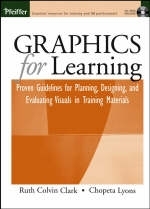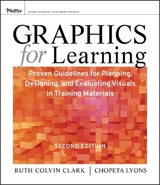
Graphics for Learning
Jossey-Bass Inc.,U.S. (Verlag)
978-0-7879-6994-3 (ISBN)
- Titel erscheint in neuer Auflage
- Artikel merken
"Graphics for Learning" teaches you how to design effective graphics for print or online and computer-generated materials multimedia, texts, working aids, and slides that will maximize learning, understanding, and reasoning. Based on solid research on how people learn, this crucial resource contains best practices and shows you how to go beyond the visible features of graphics to plan visuals that are based on their communication and psychological functions. Written by instructional design experts Ruth Colvin Clark and Chopeta Lyons, "Graphics for Learning" includes a graphic design model that guides you through the visual planning process from needs assessment through production. No matter how much or little expertise you have working with graphics, this book will help you boost your return on investment by giving you the information you need to design and implement the most effective visuals.
"Graphics for Learning" shows how to: select the graphics that can improve learning and workplace performance; plan the most appropriate visual for computer or paper instructional materials; design the best graphics for instructional content; tailor visuals for individual learners; avoid using the wrong visuals for motivational purposes; understand the characteristics of graphics that support (or disrupt) learning; and, follow a systematic graphic design model that helps you plan graphics that match your instructional context.
Ruth Colvin Clark has familiarity with the academic research in use of graphics to promote learning and has worked for over twenty years with corporate training staff assigned to design, develop, and select effective training for classroom or computer delivery. She is the author of Building Expertise and e-Learning and the Science of Instruction (Pfeiffer), both of which received the Outstanding Instructional Communication Award from the International Society of Performance Improvement. Chopeta Lyons has created award-winning print and on-line learning products during her twenty years developing training solutions. Beginning in 1983 with the design of electronic educational software, she has directed teams of designers, writers, programmers, audio talent, graphic designers and artists to create custom solutions for the training needs of numerous corporations and organizations. She is the author of several articles on e-learning and the book, Discover Writing, a college textbook on writing from Prentice Hall.
Acknowledgments. Foreword by Richard E. Mayer. Introduction: Getting the Most from This Resource. Introduction to Section One: The Foundation. Chapter 1: Three Views of Instructional Visuals. Chapter 2: A Visual Design Model for Planning Graphics Systematically. Summary of Section One. Introduction to Section Two: How to Use Visuals to Support Psychological Learning Processes. Chapter 3: How Graphics Influence Learning Processes. Chapter 4: Plan Graphics That Direct Attention. Chapter 5: Plan Graphics That Awaken Prior Knowledge. Chapter 6: Plan Graphics That Minimize Memory Load. Chapter 7: Plan Graphics to Help Learners Build Mental Models. Chapter 8: Plan Graphics That Support Transfer of Learning. Chapter 9: Plan Graphics to Motivate Learning and Manage Sizzle. Chapter 10: Plan Graphics That Accommodate Learner Differences. Summary of Section Two. Introduction to Section Three: How to Visualize Lesson Content. Chapter 11: How to Visualize Procedures. Chapter 12: How to Visualize Concepts. Chapter 13: How to Visualize Facts. Chapter 14: How to Visualize Processes. Chapter 15: How to Visualize Principles. Summary of Section Three. Introduction to Section Four: How to Plan and Communicate Your Visuals. Chapter 16: Define the Visual Context. Chapter 17: Design the Visual Approach. Chapter 18: Visualize Individual Graphics. Chapter 19: Communicate Your Graphic Plans. Chapter 20: Apply the Principles. Summary of Section Four. Glossary. References. About the Authors. List of Figures and Tables. Index. Pfeiffer Publications Guide.
| Erscheint lt. Verlag | 18.6.2004 |
|---|---|
| Zusatzinfo | Illustrations |
| Verlagsort | New York |
| Sprache | englisch |
| Maße | 186 x 239 mm |
| Gewicht | 1174 g |
| Themenwelt | Wirtschaft ► Betriebswirtschaft / Management |
| ISBN-10 | 0-7879-6994-X / 078796994X |
| ISBN-13 | 978-0-7879-6994-3 / 9780787969943 |
| Zustand | Neuware |
| Haben Sie eine Frage zum Produkt? |
aus dem Bereich



